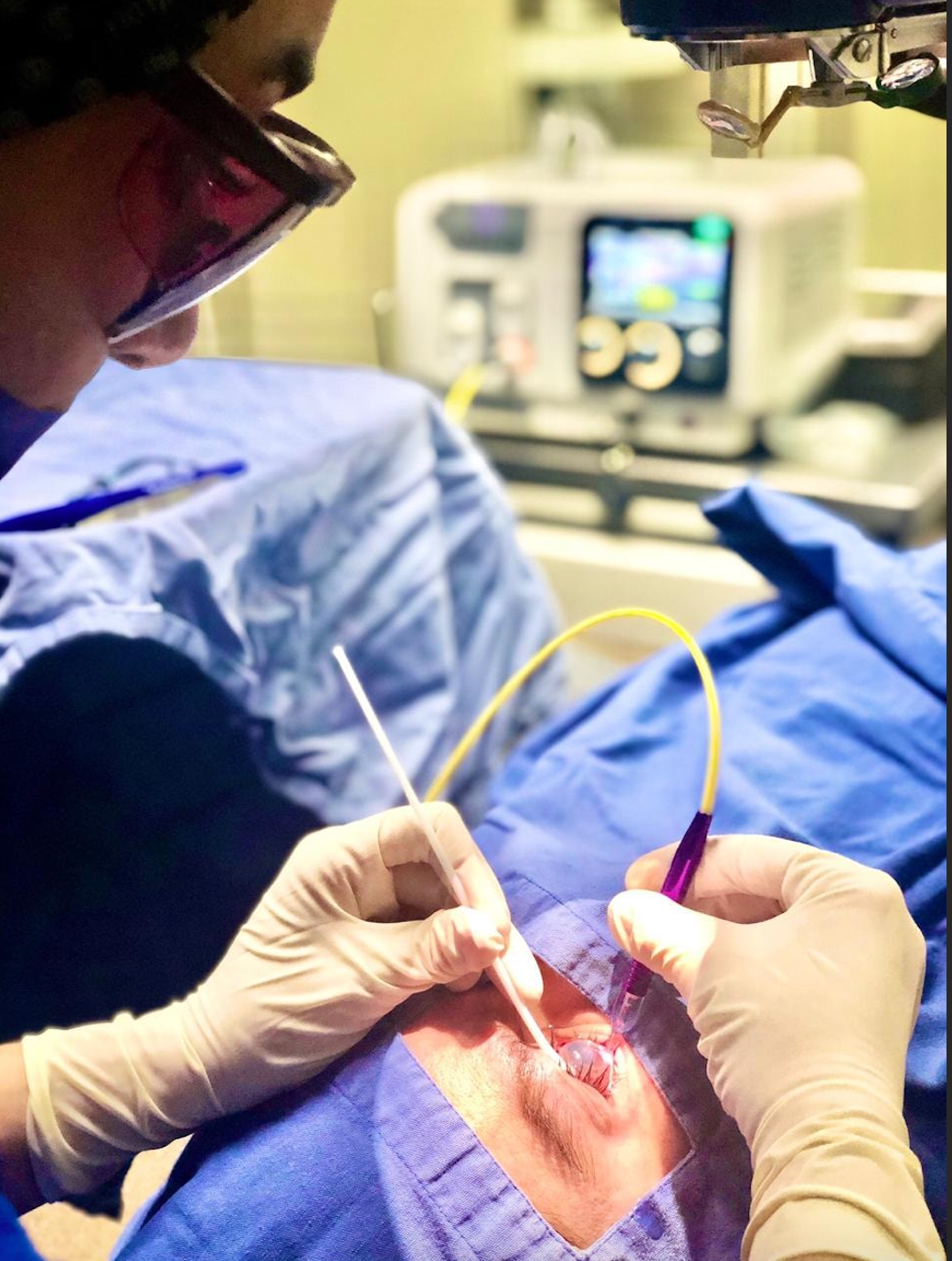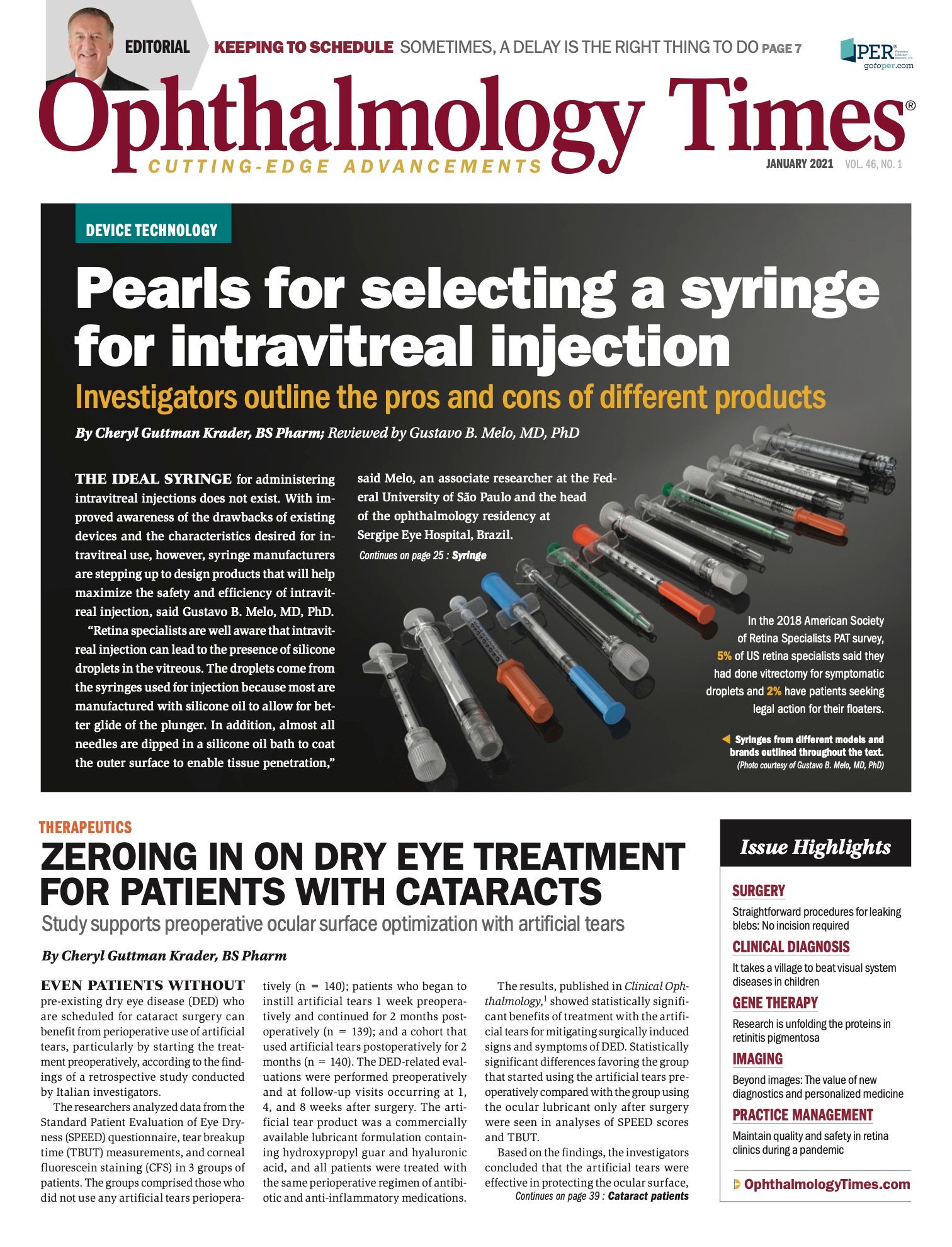Publication
Article
Digital Edition
Transscleral laser therapy device simplifies procedure
Author(s):
Noninvasive option reduces IOP in patients with glaucoma.
Photo courtesy of Brenda Alegria, MD


Special to Ophthalmology Times®
MicroPulse Transscleral Laser Therapy (MicroPulse TLT) is a nonincisional procedure that substantially reduces IOP for a broad range of glaucoma patients.1-2
Patient-friendly, safe, and effective, MicroPulse TLT is my preferred nonincisional procedure for glaucoma patients before proceeding to surgical interventions to potentially reduce the number of drop therapies or address drop failure.
Related: (AAO) Micro vacuum pick for vitreoretinal surgery may be a better mousetrap
Recently, a revised MicroPulse P3 Delivery Device was introduced to the market, and it has made the delivery of MicroPulse TLT easier to administer.
MicroPulse laser is a treatment mode in the Cyclo G6 Laser System (IRIDEX) that works by “chopping” a continuous-wave laser beam into a series of short bursts of energy with longer off periods. The energy pauses allow the tissue to cool, thus minimizing damage to surrounding tissues.
Numerous studies have demonstrated the safety and efficacy of MicroPulse TLT for a variety of glaucoma types and severity.1-4
The exact mechanism of action of MicroPulse TLT is still undetermined; however, there is research that suggests it is multifactorial in both trabecular and uveoscleral outflow.3
As with any surgery, MicroPulse TLT is subject to several variables, including surgeon technique and individual patient physiology. The revised MicroPulse P3 Device incorporates features that minimize treatment variables to improve consistency in surgeon technique.
Related: Treating Demodex blepharitis efficiently before surgery
Thoughtful design
I have been using the revised device for more than 10 months, and the overall impression is an improved ease of use. This is due to a number of revised design elements.
> A recessed fiber tip and an added fluid channel retain the gel, thus enabling consistent fiber immersion in fluid and improved light coupling to the tissue, which is necessary to effectively transmit the laser energy.
With the original MicroPulse P3 Device, I had to create a “well” of lidocaine gel on the eye during the procedure; however, the amount of gel made it difficult to see the location of the clear probe when submersed in the gel.
The revised design retains the gel within a recessed channel of the probe itself. I use less gel, which makes it cleaner and easier to visualize the probe during the procedure.
Related: Comparing outcomes of xen gel stents in glaucoma practice
> A concave, scleral-matching footplate curvature improves probe stability and makes it easier to keep the probe angled to the scleral surface during treatment.
In addition, a smaller tip makes the device more agile, makes positioning simpler, and allows for treating the smaller palpebral fissure.
> A limbal-matching curvature on the probe’s footplate has “bunny ears” that match the curve of the limbus, making it more intuitive to determine correct positioning of the probe.
> An elongated stem improves visibility and functions as a speculum to hold back the eyelids during laser delivery. This eliminates the need to maneuver the eye with forceps and prevents subconjunctival hemorrhage.
Improved ergonomics, improved results
I find the revised MicroPulse P3 Device to be simpler to handle. It allows for easier visualization of the treatment area than its predecessor. Even the junior residents at the teaching institution are able to perform MicroPulse TLT because the probe’s design makes treatment straightforward and consistent.
Repeat treatments can be administered as necessary if the initial reduction in IOP starts to rebound over time.
Related: Single administration of intracameral bimatoprost implant: IOP lowering, safety
While I still need to analyze my data with the revised probe, survival time was approximately 9 to 12 months with the original probe. I feel I am achieving excellent results while still maintaining a low-risk profile.
Case example
I had a patient who was a Caucasian man, aged 75 years, with normal tension glaucoma in both eyes. His pressure was 14-15 mm Hg in both eyes on 2 classes of medication, yet he was demonstrating disc heme, a sign that pressures are not sufficiently controlled.
This patient was not able to add additional topical therapies due to allergies, and he was not interested in filtering surgery, so I decided to treat the right eye with MicroPulse TLT in June 2019.
I saw him 1 month later and the pressure was 9 mmHg in the right eye. In May 2020, the pressure remained at 10 mm Hg. He has had a sustained response for close to 1 year with no recurrence of disc heme and a stable visual field.
Related: Comparing micro-bypass implant + phaco vs phaco in POAG
I also treated his left eye in August 2019. His preoperative IOP, which measured at 15 mm Hg, had reduced and remained stable at 11 mm Hg for 1 year following the procedure. Both eyes were treated with 2000 mW and 50 seconds per hemisphere (3 sweeps of 20 seconds each).
IRIDEX recommends 2500 mW, 50 seconds, and 5 sweeps, so I have shifted to 2500 mW. I have seen no inflammatory complications or decreases in visual acuity with this patient or others.
I have treated my patients with MicroPulse TLT successfully for many years and find it an effective and flexible treatment. I am pleased with the enhancements made to the MicroPulse P3 Device and anticipate continuing to turn to this therapy frequently to treat my patients.
Read more glaucoma content here
About the author
Jella An, MD
e:573/882-1506
An specializes in glaucoma treatment at the Mason Eye Clinic at the University of Missouri in Columbia.
--
References
1. Varikuti VNV, Shah P, Rai O, et al. Outcomes of micropulse transscleral cyclophotocoagulation in eyes with good central vision. J Glaucoma. 2019;28(10):901-905. doi:10.1097/IJG.0000000000001339
2. Yelenskiy A, Gillette TB, Arosemena A, et al. Patient outcomes following micropulse transscleral cyclophotocoagulation: intermediate-term results. J Glaucoma. 2018;27(10):920-925. doi:10.1097/IJG.0000000000001023
3. Zaarour K, Abdelmassih Y, Arej N, Cherfan G, Tomey KF, Khoueir Z. Outcomes of micropulse transscleral cyclophotocoagulation in uncontrolled glaucoma patients. J Glaucoma. 2019;28(3):270-275. doi:10.1097/IJG.0000000000001174
4. Nguyen AT, Maslin J, Noecker RJ. Early results of micropulse transscleral cyclophotocoagulation for the treatment of glaucoma. Eur J Ophthalmol. 2020;30(4):700-705. doi:10.1177/1120672119839303
5. Johnstone MA, Song S, Padilla S, et al. Microscope real-time video (MRTV), high- resolution OCT (HR-OCT) & histopathology (HP) to assess how transscleral micropulse laser (TML) affects the sclera, ciliary body (CB), muscle (CM), secretory epithelium (CBSE), suprachoroidal space (SCS) & aqueous outflow system. Invest Ophthalmol Vis Sci. 2019;60(9):2825.

Newsletter
Don’t miss out—get Ophthalmology Times updates on the latest clinical advancements and expert interviews, straight to your inbox.




